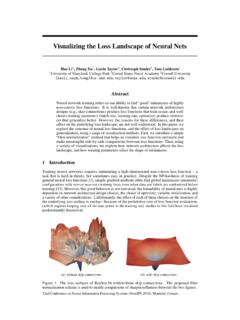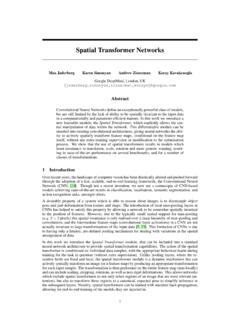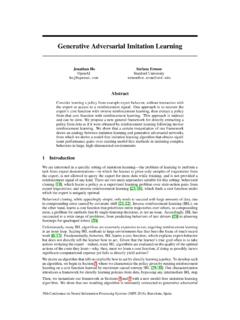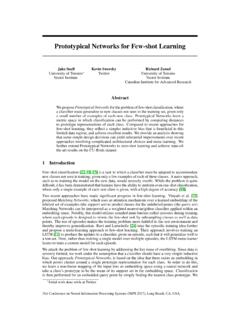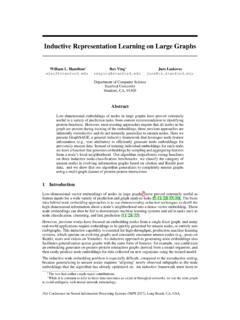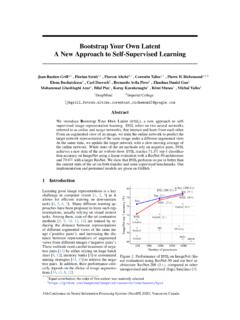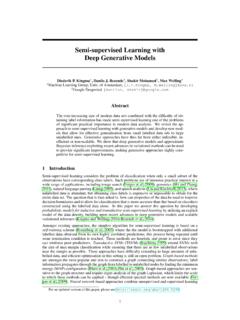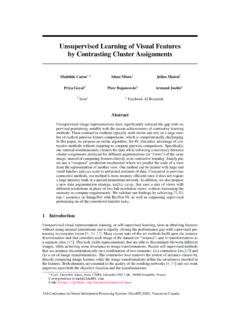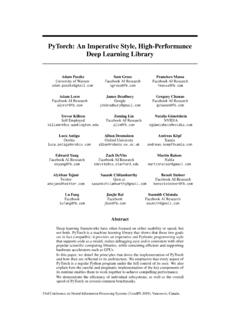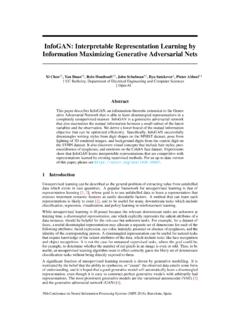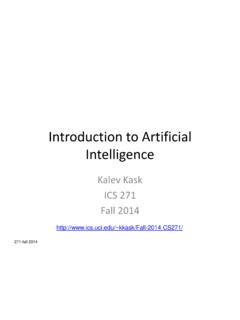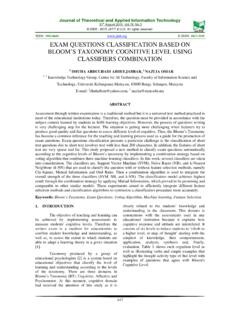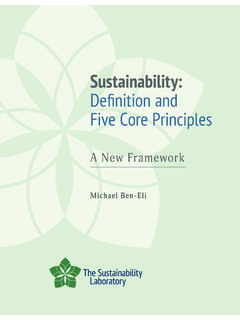Transcription of Long-Tailed Classification by Keeping the Good and …
1 Long-Tailed Classification by Keeping the Good and Removing the Bad Momentum Causal Effect Kaihua Tang1 , Jianqiang Huang1,2 , Hanwang Zhang1. 1. Nanyang Technological University, 2 Damo Academy, Alibaba Group Abstract As the class size grows, maintaining a balanced dataset across many classes is challenging because the data are Long-Tailed in nature; it is even impossible when the sample-of-interest co-exists with each other in one collectable unit, , multiple visual instances in one image. Therefore, Long-Tailed classification is the key to deep learning at scale. However, existing methods are mainly based on re- weighting/re-sampling heuristics that lack a fundamental theory. In this paper, we establish a causal inference framework, which not only unravels the whys of previous methods, but also derives a new principled solution.
2 Specifically, our theory shows that the SGD momentum is essentially a confounder in Long-Tailed classification. On one hand, it has a harmful causal effect that misleads the tail prediction biased towards the head. On the other hand, its induced mediation also benefits the representation learning and head prediction. Our framework elegantly disentangles the paradoxical effects of the momentum, by pursuing the direct causal effect caused by an input sample. In particular, we use causal intervention in training, and counterfactual reasoning in inference, to remove the bad while keep the good . We achieve new state-of-the-arts on three Long-Tailed visual recognition benchmarks1 : Long-Tailed CIFAR-10/-100, ImageNet-LT for image classification and LVIS for instance segmentation.
3 1 Introduction Over the years, we have witnessed the fast development of computer vision techniques [1, 2, 3], stemming from large and balanced datasets such as ImageNet [4] and MS-COCO [5]. Along with the growth of the digital data created by us, the crux of making a large-scale dataset is no longer about where to collect, but how to balance. However, the cost of expanding them to a larger class vocabulary with balanced data is not linear but exponential as the data will be inevitably Long-Tailed by Zipf's law [6]. Specifically, a single sample increased for one data-poor tail class will result in more samples from the data-rich head. Sometimes, even worse, re-balancing the class is impossible. For example, in instance segmentation [7], if we target at increasing the images of tail class instances like remote controller , we have to bring in more head instances like sofa and TV simultaneously in every newly added image [8].
4 Therefore, Long-Tailed classification is indispensable for training deep models at scale. Recent work [9, 10, 11] starts to fill in the performance gap between class-balanced and Long-Tailed datasets, while new Long-Tailed benchmarks are springing up such as Long-Tailed CIFAR-10/-100 [12, 10], ImageNet-LT [9] for image classification and LVIS [7] for object detection and instance segmentation. Despite the vigorous development of this field, we find that the fundamental theory is still missing. We conjecture that it is mainly due to the paradoxical effects of long tail. On one hand, it is bad because 1. Our code is available on 34th Conference on neural Information Processing Systems (NeurIPS 2020), Vancouver, Canada. All Many Medium Few M 1.
5 70. 60. Relative Change (%). D 50. Magnitude 40. X Y 30. 20. M: Momentum D: Projection on Head 10. 0 0. X: Feature Y: Prediction 0. 44. 88. 132. 176. 220. 264. 308. 352. 396. 440. 484. 528. 572. 616. 660. 704. 748. 792. 836. 880. 924. 968. Momentum Decay Ratio . Class Index (a) The Proposed Causal Graph (b) Mean magnitude of for each class (c) Relative Change of Accuracy from = Figure 1: (a) The proposed causal graph explaining the causal effect of momentum. See Section 3 for details. (b) The mean magnitudes of feature vectors for each class i after training with momentum = , where i is ranking from head to tail. (c) The relative change of the performance on the basis of = shows that the few-shot tail is more vulnerable to the momentum.
6 The classification is severely biased towards the data-rich head. On the other hand, it is good because the Long-Tailed distribution essentially encodes the natural inter-dependencies of classes TV is indeed a good context for controller any disrespect of it will hurt the feature representation learning [10], , re-weighting [13, 14] or re-sampling [15, 16] inevitably causes under-fitting to the head or over-fitting to the tail. Inspired by the above paradox, latest studies [10, 11] show promising results in disentangling the good from the bad , by the na ve two-stage separation of imbalanced feature learning and balanced classifier training. However, such disentanglement does not explain the whys and wherefores of the paradox, leaving critical questions unanswered: given that the re-balancing causes under-fitting/over- fitting, why is the re-balanced classifier good but the re-balanced feature learning bad?
7 The two-stage design clearly defies the end-to-end merit that we used to believe since the deep learning era; but why does the two-stage training significantly outperform the end-to-end one in Long-Tailed classification? In this paper, we propose a causal framework that not only fundamentally explains the previous methods [15, 16, 17, 9, 11, 10], but also provides a principled solution to further improve Long-Tailed classification. The proposed causal graph of this framework is given in Figure 1 (a). We find that the momentum M in any SGD optimizer [18, 19] (also called betas in Adam optimizer [20]), which is indispensable for stabilizing gradients, is a confounder who is the common cause of the sample feature X (via M X) and the classification logits Y (via M D Y ).
8 In particular, D denotes the X's projection on the head feature direction that eventually deviates X. We will justify the graph later in Section 3. Here, Figure 1 (b&c) sheds some light on how the momentum affects the feature X and the prediction Y . From the causal graph, we may revisit the bad Long-Tailed bias in a causal view: the backdoor [21] path X M D Y causes the spurious correlation even if X has nothing to do with the predicted Y , , misclassifying a tail sample to the head. Also, the mediation [22] path X D Y mixes up the pure contribution made by X Y . For the good . bias, X D Y respects the inter-relationships of the semantic concepts in classification, that is, the head class knowledge contributes a reliable evidence to filter out wrong predictions.
9 For example, if a rare sample is closer to the head class TV and sofa , it is more likely to be a living room object ( , remote controller ) but not an outdoor one ( , car ). Based on the graph that explains the paradox of the bad and good , we propose a principled solution for Long-Tailed classification. It is a natural derivation of pursuing the direct causal effect along X Y by removing the momentum effect. Thanks to causal inference [23], we can elegantly keep the good while remove the bad . First, to learn the model parameters, we apply de-confounded training with causal intervention: while it removes the bad by backdoor adjustment [21] who cuts off the backdoor confounding path X M D Y , it keeps the good by retaining the mediation X D Y.
10 Second, we calculate the direct causal effect of X Y as the final prediction logits. It disentangles the good from the bad in a counterfactual world, where the bad effect is considered as the Y 's indirect effect when X is zero but D retains the value when X = x. In contrast to the prevailing two-stage design [11] that requires unbiased re-training in the 2nd stage, our solution is one-stage and re-training free. Interestingly, as discussed in Section , we show that why the re-training is inevitable in their method and why ours can avoid it with even better performance. 2. On image classification benchmarks Long-Tailed CIFAR-10/-100 [12, 10] and ImageNet-LT [9], we outperform previous state-of-the-arts [10, 11] on all splits and settings, showing that the performance gain is not merely from catering to the long tail or a specific imbalanced distribution.
